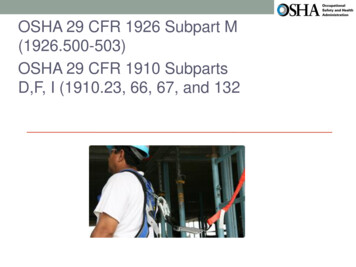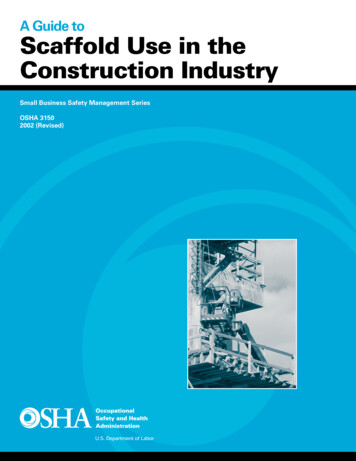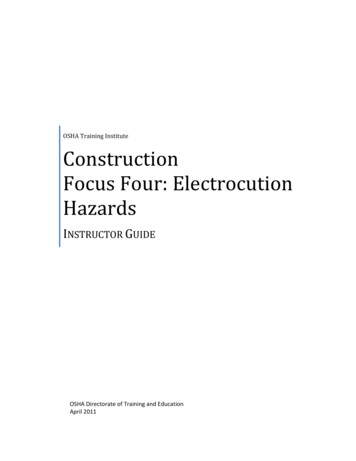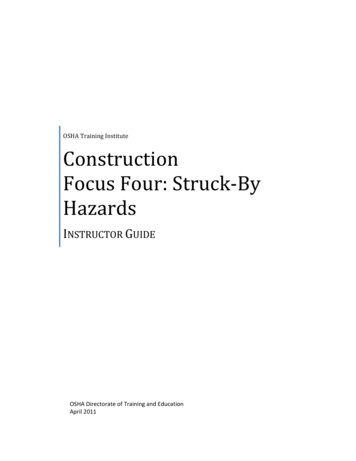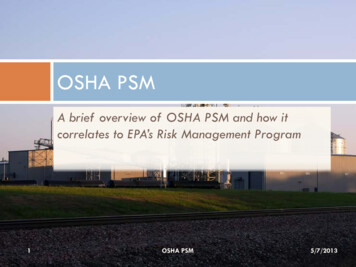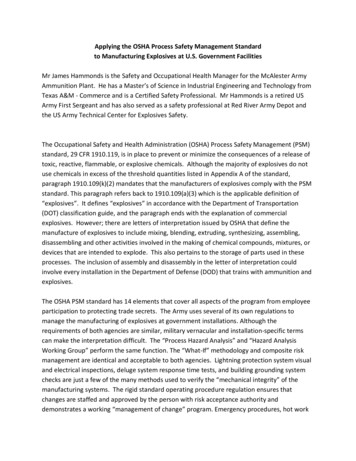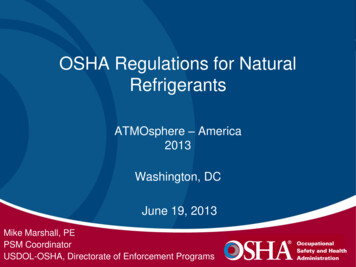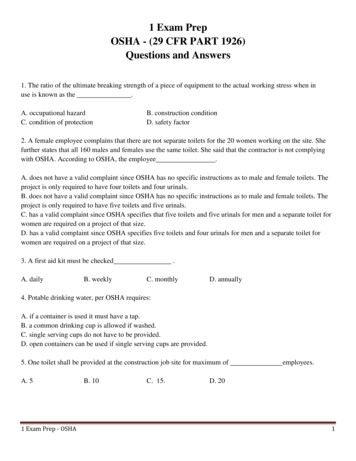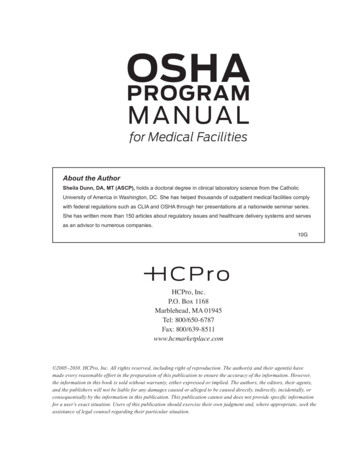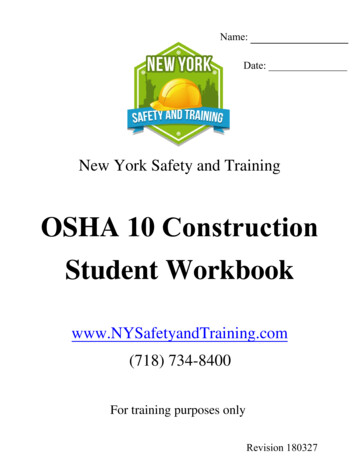
Transcription
Name:Date:New York Safety and TrainingOSHA 10 ConstructionStudent Workbookwww.NYSafetyandTraining.com(718) 734-8400For training purposes onlyRevision 180327
NAMECELL PHONECLASS DATECLASS LOCATIONINSTRUCTOR’S NAMEWhy am I taking this OSHA class?How much do I know about my rights as a worker?How much do I know about hazards at construction sites?What do I want to get out of this OSHA class?Please LIKE us on Facebook: Facebook.com/NYSafetyandTraining
Summary ofNYC Local Law 196 of 2017Site Safety Training (SST) Cards RequirementsFour Different types of Site Safety Training (SST) cards:Site Safety Training (SST) card, Limited Site Safety Training (SST) card, Temporary Site Safety Training(SST) card, and Site Safety Training (SST) Supervisor cardSite Safety Training (SST) cardQualifications: 1 of 3 options:OSHA 10 plus 30 – 45 additional SST training hours (to include 8 hours of “safeguarding against thedangers posed by falling workers and objects”)OROSHA 30 plus 10 – 25 additional SST training hours (to include 8 hours of “safeguarding against thedangers posed by falling workers and objects”)OR100-hour training program (such as an approved apprenticeship)Expiration: 5 yearsRenewal: within a year preceding renewal, attend 8 hours of SST trainingLimited Site Safety Training (SST) cardQualifications: 1 of 3 options:OSHA 301www.NYSafetyandTraining.com1
OROSHA 10 plus 20 other hours of safety training (Must include 8 hours of “safeguarding against thedangers posed by falling workers and objects”)OR100-hour training program (such as an approved apprenticeship)Expiration: May 1, 2019Renewal: NoneTemporary Site Safety Training (SST) cardQualifications: Entry level card for workers who complete OSHA 10 Construction class.Expiration: 6 monthsRenewal: noneSite Safety Training (SST) Supervisor cardQualifications: Have an SST card and OSHA 30 cardExpiration: 5 yearsRenewal: within a year preceding renewal, attend 16 hours of SST trainingTIMELINE OF ENFORCEMENTMarch 1, 2018: all workers must have one of the following three:OSHA 10 card, OSHA 30 card, or 100-hour training program certificateDecember 1, 2018 (“SST Second Compliance Date”): All workers must have one of the following three:Site Safety Training (SST) card, Limited Site Safety Training (SST) card, or Temporary Site SafetyTraining (SST) cardAll site safety managers, site safety coordinators, concrete safety managers, construction superintendents,and competent persons must have Site Safety Training (SST) Supervisor cardMay 1, 2019 (“SST Full Compliance Date”): All workers must have one of the following two:Site Safety Training (SST) card or Temporary Site Safety Training (SST) cardAll site safety managers, site safety coordinators, concrete safety managers, construction superintendents,and competent persons must have Site Safety Training (SST) Supervisor card2www.NYSafetyandTraining.com2
Thank you for choosing New York Safety and Training.Here are some Frequently Asked Questions from our students:I’m taking an OSHA 10 class. When will I receive my OSHA card?At the end of Day 2 of your OSHA class, you’ll received a signed temporary certificate. Your certificateis good for 90 days. You can use this certificate on your jobsite and during your job hunt. In themeantime, we order your card from OSHA, which is part of the federal government. OSHA mails yourcard to NYST, and we mail it to you. We will ask you to write an envelope with your address; it’s veryimportant that you put a reliable mailing address on envelope. You should receive your card in the mailsometime within a month. If your card has not arrived by 30 days from the end of class, call NYST to askhim about your card. Please do not call looking for your card before 30 days from the end of your class.What’s the difference between the OSHA 10 General Industry class and the OSHA10 Construction class?The OSHA 10 General Industry class teaches workplace safety for general workplaces, such as buildings,offices, hotels, and warehouses. This is sometimes called the “Maintenance” class, and students receive ablue stripe OSHA card. The OSHA 10 Construction class teaches basic workplace safety for constructionsites. New York City has a law that says that no worker can be at a major construction site unless thatworker has taken this OSHA 10 class within the last 5 years. OSHA 10 Construction students earn ayellow stripe card. If you’re going to be doing any type of work, including security, at a construction site,you need to take the OSHA 10 Construction class.I’m taking an OSHA class. What happens if I miss tomorrow’s Day 2 class?If you miss tomorrow’s class, you can make up Day 2 during any NYST OSHA class within the nextmonth, but you will be charged a 25 administrative processing fee to make up tomorrow’s class. If thishappens to you, you must make up Day 2 of the class; you cannot repeat Day 1 (as in, you have to attenda Saturday and a Sunday, not two Saturdays).What if I want to take more classes with NYST?NYST is very thankful to every person who takes a class with us. Once you’ve taken one class with us,you receive a 25 discount on any other class you may ever want to take (except upgrade to OSHA 30).What is the FLAGGER class?Flagger: Construction Site Traffic Safety Manager class is training for workers who want to be qualifiedto direct vehicular and pedestrian traffic around construction sites. Only workers who have taken theFlagger class are allowed to perform flagger operations. Students who complete our Flagger class inBrooklyn or the Bronx receive their Flagger photo ID at the end of class; students at other locationsreceive a temporary certificate of completion at the end of class and receive a photo ID card in the mail.This is a great certification to help make our students more competitive in the job market.What is the 4-hour SCAFFOLD class?New York City has a law that states that only workers who have completed the 4-hour Supported ScaffoldUser class are allowed to climb and work while on scaffolds. Most construction sites in NYC usescaffolds, and any worker without a scaffold card cannot be on a scaffold and is therefore limited in thework he or she can perform at the site. Students who complete our Scaffold class in Brooklyn or theBronx receive their Scaffold photo ID card at the end of class; students at other locations receive atemporary certificate of completion at the end of class and receive a Scaffold photo ID card in the mail.This is a great certification to help make our students more competitive in the job market.www.NYSafetyandTraining.com3(718) dTraining.com3
What happens if I lose my OSHA card?If you lose your OSHA card, NYST can order a replacement card for you one time from OSHA. Areplacement card will cost you 50. For us to be able to order your replacement card, we’ll need to knowthe date that you took your OSHA class. This date is on your certificate that you’ll receive at the end oftomorrow’s class. Take a picture of your certificate with your phone (and take a picture of your OSHAcard when it arrives in the mail), and keep this certificate someplace safe, in case you ever lose your card.If you lose your OSHA card a second time, you cannot get a replacement card. You’ll have to take theclass again.Does my OSHA card expire?According to OSHA, no, your OSHA card does not expire. But in New York City, the OSHA 10Construction card is only good for five years. After five years, you have to retake the class.Where can I find pictures of our class that the instructor may take?Class photos are posted on Instagram and Facebook atNYSafetyandTrainingNYST will not tag any photos of you. If you’d like, tag yourself and Share as you choose. In fact, if youtake any good pictures of yourself in class, or with your certificate or card, please “Tag” NYST:@NYSafetyandTrainingI’m taking the OSHA 10 Construction class and am interested in the OSHA 30. Howdoes that work?The OSHA 10 Construction class is the basic workplace safety class required by New York City law forall workers at construction sites. The OSHA 30 includes those same 10 hours of training, plus 20 hours ofmore in-depth topics such as cranes, excavations, and fire safety. The OSHA 30 also covers safety plansand ways to help keep your coworkers safe. The OSHA 30 is ideal for any worker who wants to becomea supervisor or take on a leadership role at the job site. The OSHA 30 is 5 or 6 days of class (the first twodays are the OSHA 10). f you take your OSHA 10 with NYST, you can count that towards your OSHA30; after your OSHA 10, you’ll only have to pay the difference in price and you can skip the first twoclasses. We only offer the OSHA 30 about three a year. Your OSHA 10 can only count towards theOSHA 30 if you take the 30 within 6 months of your OSHA 10. After 6 months, you’ll have to attend all30 hours of class of the OSHA 30, but you will still only have to pay the difference to attend the 30.How do I become a Fire Guard?There is no required class to be a Fire Guard. To become a Fire Guard, you need to take a computer testat FDNY headquarters at 9 MetroTech in Brooklyn (by Jay Street). Tests are given Monday - Friday, 8:30AM to 2:00 PM for 25. If you’re working in Construction, get your F-60 Fire Guard for TorchOperations and Construction Sites Certificate of Fitness. If you’re working in Building Maintenance orSecurity, get your F-01 Citywide Fire Guard for Impairment Certificate of Fitness. NYST offers fireguard study classes at our Brooklyn Training Center for only 100. You can pick up a study book at 9MetroTech or download the study material from the FDNY website athttp://www.nyc.gov/html/fdny/html/c of f/cof study materials.shtmlWill anyone at NYST try to sell me anything while I’m here?No. While you’re with NYST for your training, NYST instructors and staff will NOT attempt to sell youany items or equipment. No NYST personnel may sell any items to students other than official NYSTsafety training. Neither New York Safety and Training nor any NYST instructor has proprietary interestin any product, instrument, device, service, or material discussed during the learning event.www.NYSafetyandTraining.com4(718) dTraining.com4
OSHA 10 Construction CourseGoalUpon successful completion of this course, participants will have an improvedattitude about the importance of safety and will be able to identify the mostcommon hazards associated with the construction industry. Students willunderstand the role of OSHA and know their rights to safety and health asworkers.DAY 1Lesson 1 – Introduction to OSHA7Refusing to Work Because Conditions Are Dangerous8OSHA Poster9OSHA Inspections10Filing an OSHA Complaint11OSHA FactSheet: Your Rights as a Whistleblower15Safety and Health Resources17Navigating the OSHA Website18Identifying Safety and Health Problems in the Workplace20Lesson 2 – Fatality Catastrophe Report21Lesson 3 – Health Hazards in Construction:26Safety Data Sheet (SDS) Breakout Session28Safety Data Sheet32GHS Pictograms36Quiz: Health Hazards in Construction37Health Hazards: Silica38Lesson 4 –Personal Protective Equipment41Employers Must Provide and Pay for Most PPE43OSHA Quickcard: Construction PPE45Elective – Respiratory ProtectionOSHA Quickcard: Protect Yourself – RespiratorsElective – Ladder SafetyLadder Inspection Form464749
DAY 2Lesson 1 – Focus Four: Fall Hazards54Personal Fall Arrest Systems Summary55Suspension Trauma (from TagSafety.com)58Guardrail and Safety Net Systems Summary59Lesson 2 – Focus Four: Electrical HazardsToolbox Talk: Extension Cord SafetyLesson 3 – Focus Four: Struck-By HazardsQuiz: Struck-ByLesson 4 Focus Four: Caught-in or -Between HazardsQuiz: Caught-in or -Between606263666769Elective – Trench and Excavation HazardsOSHA Quickcard: Protect Yourself – Trench Safety70Review – OSHA Quickcard: Top Four Construction Hazards71Elective – Scaffold Safety Basics72Elective – Confined Spaces in Construction74Class Conclusion78
INTRODUCTION TO OSHAGoal: To introduce students to OSHA and what OSHA does for them.OBJECTIVESUpon successful completion of this lesson, students will be able to1. Explain why OSHA is important to workers2. Explain worker rights under OSHA3. Discuss employer responsibilities under OSHA4. Discuss the use of OSHA standards5. Explain how OSHA inspections are conducted6. Utilize helpful worker safety and health resourcesNOTES1. “OSHA” stands forand2. The mission of OSHA is to3. In NYC, the OSHA 10 Construction card expires in4. The tragedy that occurred in 1911 is known as5. Some of the hazards that contributed to the deaths in this 1911 event include6. OSHA states that you have the right to a andworkplace.7. When refusing to perform unsafe work, if you leave the worksite,8. True or False: You can report a hazard to OSHA confidentially.9. If you are retaliated against for exercising your safety rights, you havedays to contact OSHA7www.NYSafetyandTraining.com7
HANDOUT #3Refusing to Work because Conditions are DangerousWorkers have the right to refuse to do a job if they believe in good faith that they areexposed to an imminent danger. "Good faith" means that even if an imminent dangeris not found to exist, the worker had reasonable grounds to believe that it did exist.The United States Supreme Court, in the Whirlpool case, issued the landmark rulingwhich more clearly defined a worker's right to refuse work where an employee hasreasonable apprehension that death or serious injury or illness might occur as aresult of performing the work. However, as a general rule, you do not have theright to walk off the job because of unsafe conditions.REFUSING WORK IS PROTECTED IF:Your right to refuse to do a task isprotected if ALL of the followingconditions are met: Where possible, you have askedthe employer to eliminate thedanger, and the employer failed todo so; and You refused to work in
10 Construction class? The OSHA 10 General Industry class teaches workplace safety for general workplaces, such as buildings, offices, hotels, and warehouses. This is sometimes called the “Maintenance” class, and students receive a blue stripe OSHA card. The OSHA 10 Construction class teaches basic workplace safety for construction sites. New York City has a law that says that no worker can be at a major construction
